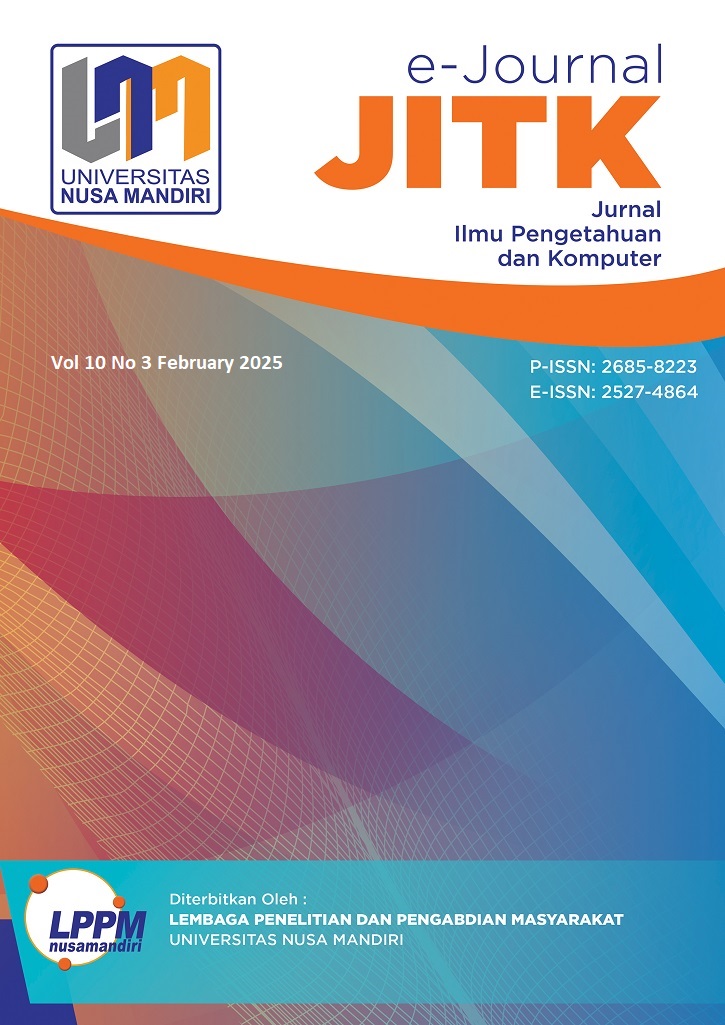INTELLIGENT SYSTEM TO DETERMINE THE BEST LECTURER USING ADDITIVE RATIO ASSESSMENT ALGORITHM
DOI:
https://doi.org/10.33480/jitk.v10i3.6281Keywords:
andalas university, decision support system, informatics, intelligent system, lecturerAbstract
The quality of a lecturer's performance is one of the keys to institutional success that must be continuously improved. The performance assessment of lecturers in the Informatics study program of the Faculty of Information Technology, Andalas University faces obstacles in processing quantitative and qualitative data so that it is vulnerable to subjectivity including research productivity, teaching effectiveness, contributions to community service and additional activities. In addition, limitations in a systematic evaluation system result in unfairness and lack of transparency in the decision-making process. The research objective is to create a technology-based approach by applying the Additive Ratio Assessment method based on a Decision Support System. The ARAS method was chosen because it is able to determine effective final results based on multiple criteria that have been determined. The application of the ARAS method consists of 5 stages, namely determining the decision matrix, normalizing the decision matrix, weighting the normalization results, determining the optimum function value and ranking results. The results obtained are alternative data consisting of A1,A2,A3,A4,A5,A6,A7,A8,A9,A10,A11 and 8 criteria and weighting, namely the last education (10%), functional position (15%), certification (20%), number of publications (15%), author order (15%), publication index quality (10%), research grants (10%) and PkM (5%). The ranking results with the highest value in order 1-5 are 0.113875, 0.109785, 0.104235, 0.099005, 0.094715. The final conclusion of this research is that the ARAS method is able to prove the best lecturer assessment to be more efficient, transparent and subjective to be applied in the Andalas University Informatics study program.
Downloads
References
D. Fatmawati and D. A. Megawaty, “Aplikasi Supervisi Dosen Berbasis Web Di Universitas XYZ,” J. Inform. dan Rekayasa Perangkat Lunak, vol. 4, no. 3, pp. 270–283, 2023, doi: 10.33365/jatika.v4i3.3100.
Supriatin, A. R. Saputra, and B. Satria, “Implementation of Aras Algorithm on Decision Support System to Determine The Best Lecturer,” JITK (Jurnal Ilmu Pengetah. Dan Teknol. Komputer), vol. 8, no. 1, pp. 25–32, 2022, doi: 10.33480/jitk.v8i1.3152.
F. Tira Wulandari, A. Triayudi, Mesran, and K. Sussolaikah, “Sistem Pendukung Keputusan Penilaian Kinerja Dosen Menggunakan Metode (COPRAS),” J. Inf. Syst. Res., vol. 5, no. 2, pp. 592–602, 2022, doi: 10.34012/jutikomp.v5i1.2579.
A. Lisdiyanto, “Sistem Penilaian Kinerja Tridharma Dosen Menggunakan SAW,” J. Teknol. Dan Sist. Inf. Bisnis, vol. 5, no. 1, pp. 69–72, 2023, doi: 10.47233/jteksis.v5i1.760.
A. Martin and M. Kristina, “Implementasi Metode AHP Dalam Perancangan Sistem Pendukung Keputusan Penilaian Kinerja Dosen Untuk Meningkatkan Kualitas Sdm Stmik Pringsewu,” J. Softw. Eng. Technol., vol. 3, no. 1, pp. 23–30, 2023.
S. Syam and N. Komalasari, “Implementasi Metode WASPAS Dalam Sistem Pendukung Keputusan Pemilihan Dosen Terbaik,” Jutis (Jurnal Tek. Inform., vol. 11, no. 2, pp. 151–159, 2023.
A. R. Saputra and Supriatin, “Implementasi Algoritma ARAS Pada SPK Untuk Menentukan Peringkat Dosen Terbaik,” Indones. J. Comput. Sci., vol. 11, no. 2, pp. 578–591, 2022, doi: 10.33022/ijcs.v11i2.3057.
R. Efanda, Yuswardi, and Maryanti, “Sistem Pendukung Keputusan Penilaian Kinerja Dosen di Universitas Jabal Ghafur Menggunakan Metode 360 Degree Berbasis Web,” Sagita Acad. J., vol. 2, no. 2, pp. 104–108, 2024.
H. Sugara, E. P. Parapat, E. D. Siringo-ringo, M. Yunus, M. A. Hanafiah, and Y. D. Lestari, “Sistem Pendukung Keputusan Pemilihan Calon Pustakawan Menggunakan Metode Aras,” J. TEKINKOM, vol. 7, no. 1, pp. 292–299, 2024, doi: 10.37600/tekinkom.v7i1.1055.
S. B. Atim and R. Arundaa, “Metode A New Additive Ratio Assessment (ARAS) Dalam Penentuan Pegawai Honor Berprestasi,” J. Inf. Technol. Softw. Eng. Comput. Sci., vol. 2, no. 1, pp. 40–48, 2024.
A. D. Wahyudi, “Analisis Kepuasan Terhadap Pelayanan Supplier Menggunakan Metode A New Additive Ratio Assessment ( ARAS ),” J. Artifisial Intell. Tecnol. Inf., vol. 2, no. 1, pp. 1–13, 2024.
M. S. Lengkong, N. Dengen, and F. Agus, “Sistem Pendukung Keputusan Pemilihan Objek Wisata Kabupaten Berau Menggunakan Metode Additive Ration Assessment ( ARAS ),” IKRAITH-INFORMATIKA, vol. 9, no. 1, pp. 114–122, 2025.
N. Rizqullah, M. G. Resmi, and I. Kaniawulan, “Penentuan Daerah Berpotensi Kekurangan Distribusi Air Bersih Menggunakan Metode Additive Ratio Assessment ( ARAS ) (Studi Kasus : PDAM Purwakarta),” JATI (Jurnal Mhs. Tek. Inform., vol. 8, no. 5, pp. 9833–9841, 2024.
A. P. Sari and Supiyandi, “Sistem Pendukung Keputusan Perekrutan Panitia Pemilihan Kecamatan Menggunakan Metode Additive Ratio Assessment,” Sist. Pendukung Keputusan dengan Apl., vol. 3, no. September, 2024.
Z. S. Sudirman, A. A. H. Usman, S. Do Abdullah, and A. Fuad, “Comparison of Additive Ratio Assessment Methods (Grade) and Evaluation Based on Distance From Average Solution (Edas) in Choosing a Delivery Service Company in Ternate City,” J. Jar. dan Teknol. Inf. ), vol. 6, no. 1, pp. 1–5, 2024, doi: 00.0000/jati.
M. Iqbal, B. Satria, and T. Radillah, “Implementasi SPK Menggunakan Metode ARAS Untuk Penentuan SMA dan SMK Terbaik Berbasis Website,” Indones. J. Comput. Sci., vol. 10, no. 2, pp. 425–435, 2021.
B. Satria, “Implementation of Additive Ratio Assessment (ARAS) Method on Decision Support System for Recipient of Inhabitable House,” JITK (Jurnal Ilmu Pengetah. Dan Teknol. Komputer), vol. 6, no. 1, pp. 121–128, 2020, doi: 10.33480/jitk.v6i1.1389.
Downloads
Published
How to Cite
Issue
Section
License
Copyright (c) 2025 Wahyudi Wahyudi, Budy Satria, Lutfil Khairi

This work is licensed under a Creative Commons Attribution-NonCommercial 4.0 International License.











-a.jpg)
-b.jpg)














